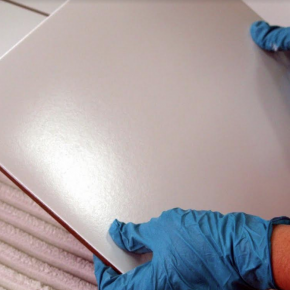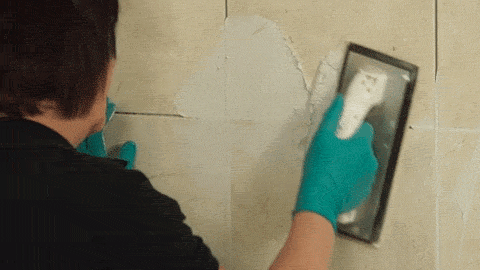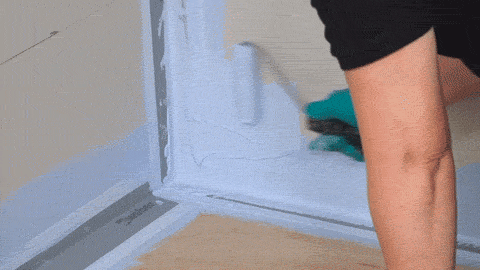
How to stop water leaking through bathroom and shower tiles with Saint-Gobain Weber
If your shower is leaking through your tiles, then this article from Saint-Gobain Weber will prove very useful.
Leaky tiles can occur anywhere where water is used, whether it’s a shower, a wet room or a kitchen splashback.
They can often cause damp and mould within surfaces behind tiles, and can even threaten the structural integrity of walls, so it’s important to tackle the issue at the first sign of a leak.
Water getting behind tiles can also damage the tile adhesive, which could cause tiles to come loose, and possibly fall off the wall altogether.
So how can you stop water getting behind tiles? This guide will see Saint-Gobain Weber go through how to replace grout and silicone, which will seal the tiles without having to remove them.
If there is a serious leak though, the tiles will need to be removed and a waterproofing system installed before putting them back.

If grout is visibly cracked or crumbling, it’s likely going to be letting water behind the tiles.
Even if the grout doesn’t appear to be damaged, if it’s not water-resistant it could potentially be the source of the leak. Either way, it’s probably a good idea to remove and replace – particularly any grout that is visibly damaged.
Grout can be removed by hand either using a manual grout removal tool or power tool with an oscillating action, both of which are widely available from hardware stores. To ensure no damage is done to the tiles, it is a good idea to tape off the grout lines before you begin the removal process.
Before applying new grout, ensure tiles are firmly adhered and that the gaps in between are clean. A squeegee or rubber float can then be used to apply water-resistant grout in small sections.
Guarantee a smooth, even finish is created with no gaps which could cause further problems down the line.
Remove excess grout from tile surfaces as soon as possible, and then leave to dry for around half an hour. Finally, a damp emulsifying pad or sponge can be used to clean any remaining grout residue from the tile surface.
Saint-Gobain Weber recommend weberjoint premium grout, which is not only water-resistant and mould-resistant, but has been formulated with PURE CLEAN anti-stain technology, so is ideal for any re-grouting that is needed.
It is available in 18 colours, which have been colour matched to the company’s silicone sealant, so there is plenty of choice when it comes to the finish.
![]()
Water can also seep around the edges of tiled areas. To prevent this from happening, a silicone sealant should be used to seal the joints between tiles and other surfaces such as windows, sinks and walls at the edges of splashbacks.
If the silicone seal has been broken, this should be removed before applying new sealant. This can be done using a sharp knife or chisel, ensuring all appropriate safety measures are taken. Extra care should be taken not to damage tiles when removing the silicone.
As with grout, it is important to ensure the chosen silicone is mould and fungus resistant if it is intended for use in wet areas.
Surfaces must be clean and dry before sealant is applied into joints, using a spatula to smooth it in. Finish by cleaning off any excess before it cures.
weberjoint silicone is the recommended sealant, which will cure to form a tough, watertight seal. It is available as a clear sealant, as well as in the 18 colours of its premium grout, so ideal for finishing the job.

As a last resort, the tiles may need to be removed in order to fix any leaks. To give walls (and tiles) the correct protection, it is a good idea to use an under tile tanking kit, which is a waterproofing system specifically designed for use in bathrooms and wet rooms.
Apply the tanking paint with a roller, covering the area to protect surfaces in wet areas. This will help to prevent water damage to surfaces in case of a leak or future damage to grout and sealant.
webersys protect is the company’s ready-mixed tanking kit, which is ideal for waterproofing showers or bathrooms.
It comes as a kit with everything needed to protect walls from water – primer, tanking paint and tanking tape.
Saint-Gobain Weber
Dickens House, Enterprise Way
Maulden Road
Flitwick
Bedford
MK45 5BY
UK
Visit Saint-Gobain Weber's website
Visit Supplier's page
Latest news

28th March 2025
Ideal Heating Commercial announces 10-year warranty on Evomax 2 boiler
Evomax 2, the UK’s number one selling commercial wall-mounted boiler from Ideal Heating Commercial, is now available with a 10-year warranty.
Posted in Articles, Building Industry News, Building Products & Structures, Building Regulations & Accreditations, Building Services, Facility Management & Building Services, Heating Systems, Controls and Management, Heating, Ventilation and Air Conditioning - HVAC, Innovations & New Products, Pipes, Pipes & Fittings, Plumbing, Retrofit & Renovation, Sustainability & Energy Efficiency, Videos
28th March 2025
FLIR Si1-LD Acoustic Imaging Camera for Compressed Air Leak Detection
FLIR, a Teledyne Technologies company, introduces the Si1-LD, an industrial acoustic imaging camera that brings faster and more accurate compressed air leak detection to those operating on a modest condition monitoring budget.
Posted in Acoustics, Noise & Vibration Control, Articles, Building Industry News, Building Products & Structures, Building Services, Facility Management & Building Services, Information Technology, Innovations & New Products, Retrofit & Renovation, Sustainability & Energy Efficiency, Thermal Imaging and Monitors
28th March 2025
LIFTEX 2025 Seminar programme announced
Registration has opened for LIFTEX 2025. Now in its 37th year, LIFTEX 2025 is the UK’s only dedicated exhibition for the lift, escalator and access industry and takes place only once every three years.
Posted in Access Control & Door Entry Systems, Accessibility, Articles, Building Industry Events, Building Industry News, Building Products & Structures, Building Regulations & Accreditations, Building Services, Exhibitions and Conferences, Facility Management & Building Services, Health & Safety, Retrofit & Renovation, Security and Fire Protection, Seminars
28th March 2025
MCRMA welcomes ArcelorMittal UK to membership
A UK division of the global steelmaking business ArcelorMittal has become the latest new member of the MCRMA, the industry association representing the metal building envelope sector.
Posted in Articles, Building Associations & Institutes, Building Industry News, Building Products & Structures, Building Systems, Cladding, Facades, Posts, Restoration & Refurbishment, Retrofit & Renovation, Roofs, Steel and Structural Frames, Walls
 Sign up:
Sign up: